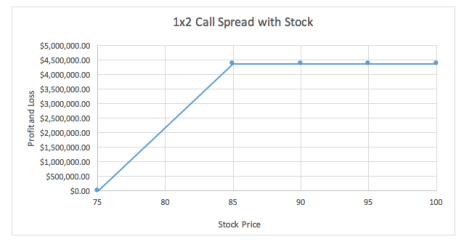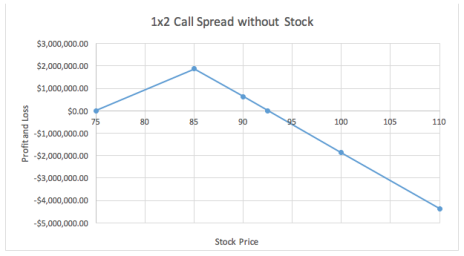As the market has rebounded just short of 2018 highs, an interesting and somewhat complex trade structure has become popular: 1x2 Bull Call Spreads.
Here are some of these trades made in the last two days:
Buyer of 2,500 x 5,000 Wayfair (W) April 77.5/85 Bull Call Spreads – Stock at 73.6 (recent earnings loser – ideal spot is 85)
Buyer of 7,5000 x 15,000 Lowe’s (LOW) March 98/103 Bull Call Spreads for $1.63 – Stock at 97 (earnings 2/28 – ideal spot is 103)
Buyer of 5,000 x 10,000 Ross Stores (ROST) April 82.5/87.5 Bull Call Spreads – Stock at 79.65 (earnings 3/6 – ideal spot is 87.5)
I’ll focus on the Wayfair trade because the stock fell from 97 to a low of 68.5 on earnings last week.
First, let’s assume the trader owns 250,000 shares of W and took a bit hit last week when the stock crumbled. One way to dig his way out of this hole is to execute the April 77.5/85 Bull Call Spread 1x2.
First let’s understand what this means.
The trader owns 250,000 shares.
The trader bought 2,500 April 77.5 Calls.
The trader sold 5,000 April 85 Calls.
Assuming the stock is trading at 75 today, and W will rally to 85 on April expiration, the trader would make back $2.5 million on his stock position. He would ALSO make $1.875 million on his 2,500 April 77.5 Calls that are now worth $7.5 with the stock at 85.
However, above 85, he would be taken out of his stock and option position because he sold twice as many calls. The owner of the 5,000 April 85 Calls would exercise his right to buy the stock at 85.
The trader likely sold twice as many calls to lower the premium paid in the trade and because he felt the upside to the stock was limited.
Here is the profit and loss graph of this position:
Now let’s assume the trader is a sophisticated hedge fund with no margin issues and can take big risk. This time, the trader does not own the stock and executes the same 1x2 bull call spread.
If the stock closes at 85 on April expiration, the 2,500 April 77.5 Calls that the trader purchased will net him $1.875 million, and the 5,000 April 85 Calls will expire worthless. This is a dream scenario.
However, if the stock goes above 85, the trader has huge upside risk because he’d be short more calls than he is long. He doesn’t have the stock component to protect him like the trader in the previous example.
Here is the profit and loss graph of this position:
As the graph shows, there is massive upside risk to this position, and thus the typical trader can’t execute a 1x2 bull call spread without owning the stock.
As I noted above, I’ve seen more and more of these trades made recently. Big picture, my read on why this strategy is becoming popular is that traders believe there is more upside in stocks, but not considerably more.
I know this options education piece is a bit complex, however as I’ve noted more and more of these trades in my daily order flow list, I felt that explaining the scenarios would be of value.

